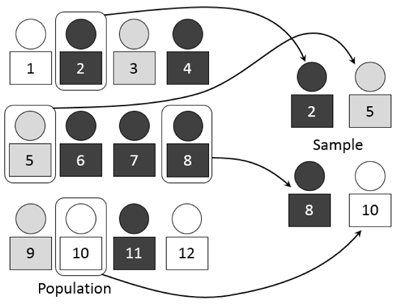Module 3: Elements of Research - Section 4
Section 4: Random Selection
 Random selection is a form of sampling where a representative group of research participants is selected from a larger group by chance. This can be done by identifying all of the possible candidates for study participation (e.g., people attending the County fair on a Tuesday) and randomly choosing a subset to participate (e.g., selecting every 10th person who comes through the gate). This allows for each person to have an equal chance of participating in the study.
Random selection is a form of sampling where a representative group of research participants is selected from a larger group by chance. This can be done by identifying all of the possible candidates for study participation (e.g., people attending the County fair on a Tuesday) and randomly choosing a subset to participate (e.g., selecting every 10th person who comes through the gate). This allows for each person to have an equal chance of participating in the study.
 Allowing each person in the group an equal chance to participate increases the chance that the smaller group possesses characteristics similar to the larger group. This produces findings that are more likely to be representative of and applicable to the larger group. Therefore, it is extremely important to adhere to this procedure if it is included in the research design. Ignoring or altering random selection procedures compromises the research design and subsequent results. For example, friends or relatives may be easier or more convenient to recruit into a research study, but selecting these individuals would not reflect a random selection of all of the possible participants. Similarly, it would be wrong to select only individuals who may potentially benefit from study participation rather than randomly selecting from the entire group of individuals being studied. Ignoring random selection procedures when they are called for in the research design reduces the quality of the information collected and decreases the usefulness of the study findings.
Allowing each person in the group an equal chance to participate increases the chance that the smaller group possesses characteristics similar to the larger group. This produces findings that are more likely to be representative of and applicable to the larger group. Therefore, it is extremely important to adhere to this procedure if it is included in the research design. Ignoring or altering random selection procedures compromises the research design and subsequent results. For example, friends or relatives may be easier or more convenient to recruit into a research study, but selecting these individuals would not reflect a random selection of all of the possible participants. Similarly, it would be wrong to select only individuals who may potentially benefit from study participation rather than randomly selecting from the entire group of individuals being studied. Ignoring random selection procedures when they are called for in the research design reduces the quality of the information collected and decreases the usefulness of the study findings.
Definition: Random selection is the process of selecting a smaller group of individuals from a larger group to be participants in a study. Every person has an equal chance of being selected, which allows each of the individuals in the group the same chance of participating.
Case Example for Random Selection
 The investigator selects 200 names from a list of 50,000 Latina women by placing all of their names in a hat. Each name is put on a separate piece of paper and names are drawn until 200 names have been picked. This procedure to select names at random can also be done by using special computer programs. A computer program would probably be used for this process when there are hundreds of participants to randomly choose.
The investigator selects 200 names from a list of 50,000 Latina women by placing all of their names in a hat. Each name is put on a separate piece of paper and names are drawn until 200 names have been picked. This procedure to select names at random can also be done by using special computer programs. A computer program would probably be used for this process when there are hundreds of participants to randomly choose.
Section 4: Discussion Questions
- Do the women included on this list represent the larger group?
- Would you choose participants differently if this was your study? If so, how would you do it?
- What if the researcher decided to ignore the random selection procedures as described in this example (e.g. pulling names from a hat, using a computer program to generate random numbers)? How would this affect the results of the study?





